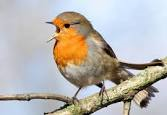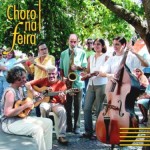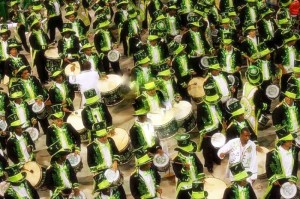Open Air Music
One of the biggest changes in my lifespan, and probably one of the less desirable, has been the ability to propagate sound over distances. Sound is a compressional wave in the air which dies away quite quickly with distance, as well as being disturbed by other air movement, so it is often carried away by the wind. In the absence of “civilising” man, there thus tends to be a silence, except for the sounds of nature close by. But now, the joining of sound with sophisticated electronics has changed all that…..!
Sounds of Nature
When I was a boy growing up in North London, the sounds I remember were the songs of birds – the thrush, blackbird, and the remarkable robin (who produces cascades of loud notes from his tiny frame). Together with the occasional chuff chuff of the steam train and belch of a lorry, that was about it. Though aeroplanes were tremendously loud, they were so infrequent as to be a source of excitement rather than resentment.
Now, spending more time in Itaipava, away from Rio and its continuous hum of traffic, I have become conscious again of birdsong, with new sounds which I cannot yet identify. In Rio, perhaps the easiest to identify is the Bem-te-vi: this is a medium-size bird with a yellow breast, white throat with a pronounced black stripe across his eye, who says in a raucous fashion Bem-te-vi-i-i. (http://www.youtube.com/watch?v=neEgnHpv2FI). In English, he has the imposing name of Great Kiskadee! Then there is the tudt-tudt-tudt of the humming birds coming to take a look at your flowers, the screech of the green parakeets (there is quite a flock of them on the Aterro), the cheep of the pardals (House sparrows – nothing to do with speed limits), and if you’re lucky, the melodious, flute-like song of the Sabiá Laranjeira, or rufous-bellied thrush. Now up in the hills I’m going to watch out for the rare sound of the Uirapuru, or organ wren, who sings clear pure notes well separated from one another. Tough ask, because he apparently only does this for 15 days in the year, while building a nest to attract the female!
Unamplified Music in the open air
Sound is produced by something vibrating, which sets up pressure waves in the air. These in turn make our eardrum vibrate, which sets up electrical impulses in the brain. For transmission, air is essential – but amplification is a problem, as is canalizing the sound. Traditionally, amplification is done by using a resonant cavity – a surrounding structure which has some natural vibrating frequencies which are excited in sympathy with the original sound, and this produces more intense sounds waves in the air. So a singer uses the chest, throat and mouth cavity to amplify the vibrations of the vocal chords, excited by the pressure of air from below; the wooden casing of the violin (or viola or cello or bass) amplifies the sound of the string vibrating as the bow is drawn across it; the clarinet and oboe amplify the vibrations of a reed, while the trumpet and horns amplify the vibrations of the player’s lips.
Canalizing natural sound is another problem: it spreads out in spherical fashion, unless there is some reflecting surface to push it back again. Something can be done with piping – as in the stethoscope and voicepipes – which have the merit of simplicity and continuing to work if there is a power failure!
But by and large, in the open air music does not carry, unless there are no interfering sounds, and no wind – and what first comes to mind is the way sound travels in the still of the mountains: I can remember sitting on one side of a Scottish glen, and hearing clearly the sounds of the kitchen and voices from a cottage that was so far away on the other side it was tiny! And nothing like the skirl of the bagpipes heard from afar! Yodelling and Alpine horns were used as means of communication thanks to the quiet of the high mountains.
Another way of getting unamplified sound to travel more is by using a natural amphitheatre or bowl to reflect part of the sound back to a focal area, from where it spreads out even stronger. The reflecting surface may be natural (like a rock formation) or a shell-like structure over the top and behind the performers. Some natural amphitheatres are quite remarkable in the way they get sound to carry to the audience.
In Rio, there are still two cultures which resist the tendency to amplification: the Roda de Choro is a surprising one, because all the instruments of Choro are lightweights – bandolim, cavaquinho, guitar, flute, and pandeiro are typical members of the group. The “Choro na Feira” group used to play every Saturday in General Glicério, but now you can here them or others at night in the Praça São Salvador in Laranjeiras.
At midday on Sundays there is a group “Choro no Parque” who play in the Parque de Ruinas in Santa Teresa, and the Parque Garota de Ipanema also has groups playing during the day. Many kiosks along the seafront, from Leme to Barra, also have their Rodas de Choro or Rodas de Samba. Nothing quite like sipping a beer by the sea, watching the beach people and hearing all those sambas which everyone seems to know by heart!
But the piéce de resistance is of course the Bateria de Samba, firmly entrenched in popular culture. The rhythm instruments themselves are not amplified (thank heavens) but a singer or cavaquino will be, if they are to be heard. One of the things I find exciting about the Samba percussion is that the bass drums have a sound which carries more, while the smaller instruments which do the cross-rhythms have a smaller reach. So when the band is approaching you get gradually drawn into the pulse, which is at its most complex and compelling when it is right by you. And do you resist joining in?
Amplified music in the open air – Sounds of Rio
Now once you apply electronics to capturing, amplifying and transmitting sound, then we get into our modern world – of announcement vans, souped-up cars (how can they stand that tremendous thud thud all the time?), open-air symphony concerts (wonderful!) and of course Rock concerts, which are simply amazing for their sound and visual effects, and the number of people they attract….
So even if it rains……..Good Listening!


